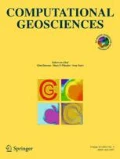Abstract
We present a general compositional formulation using multi-point flux mixed finite element (MFMFE) method on general hexahedral grids. The mixed finite element framework allows for local mass conservation, accurate flux approximation, and a more general treatment of boundary conditions. The multi-point flux inherent in MFMFE scheme allows the usage of a full permeability tensor. The proposed formulation is an extension of single and two-phase flow formulations presented by Wheeler and Yotov, SIAM J. Numer. Anal. 44(5), 2082–2106 (35) with similar convergence properties. Furthermore, the formulation allows for black oil, single-phase and multi-phase incompressible, slightly and fully compressible flow models utilizing the same design for different fluid systems. An accurate treatment of diffusive/dispersive fluxes owing to additional velocity degrees of freedom is also presented. The applications areas of interest include gas flooding, CO 2 sequestration, contaminant removal, and groundwater remediation.
Similar content being viewed by others
References
Acs, G., Doleschall, S., Farkas, E.: General purpose compositional model. Old SPE J. 25(4), 543–553 (1985)
Baker, L.E., Pierce, A.C., Luks, K.D.: Gibbs energy analysis of phase equilibria. SPE J. 22(5), 731–742 (1982)
Brezzi, F., Douglas, J., Duràn, R.Jr., Fortin, M.: Mixed finite elements for second order elliptic problems in three variables. Numer. Math. 51(2), 237–250 (1987)
Chang, Y.-B.: Development and application of an equation of state compositional simulator (1990)
Chen, C., Wang, Y., Li, G.: Closed-loop reservoir management on the brugge test case. Comput. Geosci. 14, 691–703 (2010)
Coats, K.: An equation of state compositional model. Old SPE J. 20(5), 363–376 (1980)
Farkas, E.: Linearization techniques of reservoir-simulation equations: fully implicit cases. SPE J. 3(4) (1998)
Firoozabadi, A., Pan, H.: Fast and robust algorithm for compositional modeling: part i-stability analysis testing. SPE J. 7(1), 79–89 (2002)
Fussell, L.T., Fussell, D.D.: An iterative technique for compositional reservoir models. SPE J. 19(4) (1979)
Fussell, L.T.: Technique for calculating multiphase equilibria. SPE J. 19(4), 203–210 (1979)
Hajibeygi, H., Tchelepi, H.A.: Compositional multiscale finite-volume formulation. SPE J. 19(2) (2014)
Heidemann, R.A., Michelsen, M.L.: Instability of successive substitution. Ind. Eng. Chem. Res. 34(3), 958–966 (1995)
Ingram, R., Wheeler, M.F., Yotov, I.: A Multipoint flux mixed finite element method on hexahedra. SIAM J. Numer. Anal. 48(4), 1281–1312 (2010)
Kazemi, H., Vestal, C.R., Shank, D.G.: An efficient multicomponent numerical simulator. SPE J. 18(5) (1978)
Lauser, A., Hager, C., Helmig, R., Wohlmuth, B.: A new approach for phase transitions in miscible multi-phase flow in porous media. Adv. Water Resour. 34(8), 957–966 (2011)
Martinez, M.J., Stone, C.M.: Considerations for developing models of multiphase flow in deformable porous media. SANDIA REPORT, SAND2008-5887 (2008)
Mehra, R.K., Heidemann, R.A., Aziz, K.: Computation of multiphase equilibrium for compositional simulation. SPE J. 22(1), 61–62 (1982)
Michelsen, M.L.: The isothermal flash problem. part i. stability. Fluid Phase Equilib. 9(1), 1–19 (1982a)
Michelsen, M.L.: The isothermal flash problem. part ii. phase-split calculation. Fluid Phase Equilib. 9(1), 21–40 (1982b)
Michelsen, M.L.: Calculation of multiphase equilibrium. Comput. Chem. Eng. 18(7), 545–550 (1994)
Nghiem, L.X., Fong, D.K., Aziz, K.: Compositional modeling with an equation of state. SPE J. 21(6) (1981)
Okuno, R., Johns, R.T., Sepehrnoori, K.: A new algorithm for rachford-rice for multiphase compositional simulation. SPE J. 15(2), 313–325 (June 2010)
Pan, H., Firoozabadi, A.: Fast and robust algorithm for compositional modeling: part ii-two-phase flash computations. SPE J. 8(4), 380–391 (2003)
Peng, D.-Y., Robinson, D.B.: A new two-constant equation of state. Indust. Eng. Chem. Fund. 15(1), 59–64 (1976)
Peters, E., Arts, R., Brouwer, G., Geel, C.: Results of the Brugge benchmark study for flooding optimisation and history matching. SPE 119094-MS. SPE Reservoir Simulation Symposium (2009)
Rachford, H.H., Rice, J.D.: Procedure for use of electronic digital computers in calculating flash vaporization hydrocarbon equilibrium. Trans. Am. Instit. Min. Metall. Eng. 195, 327–328 (1952)
Roebuck, I.F. Jr., Henderson, G.E., Douglas, J. Jr., Ford, W.T.: The compositional reservoir simulator: case I-the linear model. Old SPE J. 9(01), 115–130 (1969)
Russell, T.F., Wheeler, M.F.: Finite element and finite difference methods for continuous flows in porous media. Math. Reserv. Simul. 1, 35–106 (1983)
Singh, G., Pencheva, G., Kumar, K., Wick, T., Ganis, B., Wheeler, M.F.: Impact of Accurate Fractured Reservoir Flow Modeling on Recovery Predictions. SPE Hydraulic Fracturing Technology Conference (2014)
Sun, S., Firoozabadi, A.: Compositional Modeling in Three-Phase Flow for CO2 and other Fluid Injections using Higher-Order Finite Element Methods. SPE Annual Technical Conference and Exhibition (2009)
Thomas, S.G.: On some problems in the simulation of flow and transport through porous media. PhD. Thesis (2009)
Watts, J.W.: A compositional formulation of the pressure and saturation equations. SPE Reserv. Eng. 1(3), 243–252 (1986)
Wheeler, M.F., Xue, G.: Accurate locally conservative discretizations for modeling multiphase flow in porous media on general hexahedra grids. Proceedings of the 12th European Conference on the Mathematics of Oil Recovery-ECMOR XII, publisher EAGE (2011)
Wheeler, M., Xue, G., Yotov, I.: A multipoint flux mixed finite element method on distorted quadrilaterals and hexahedra. Numer. Math. 121(1), 165–204 (2011a)
Wheeler, M.F., Yotov, I.: A Multipoint flux mixed finite element method. SIAM J. Numer. Anal. 44(5), 2082–2106 (2006)
Wheeler, M.F., Xue, G., Yotov, I.: A family of multipoint flux mixed finite element methods for elliptic problems on general grids. Proc. Comput. Sci. 4, 918–927 (2011b)
Wilson, G.: A modified redlich-kwong equation of state applicable to general physical data calculations. Paper No15C, 65th AIChE National meeting (1968)
Wong, T.W., Firoozabadi, A., Aziz, K.: Relationship of the volume-balance method of compositional simulation to the Newton-Raphson method. SPE Reserv. Eng. J. 5(3) (1990)
Young, L., Stephenson, R: A generalized compositional approach for reservoir simulation. Old SPE J. 23 (5), 727–742 (1983)
Author information
Authors and Affiliations
Corresponding author
Rights and permissions
About this article
Cite this article
Singh, G., Wheeler, M.F. Compositional flow modeling using a multi-point flux mixed finite element method. Comput Geosci 20, 421–435 (2016). https://doi.org/10.1007/s10596-015-9535-2
Received:
Accepted:
Published:
Issue Date:
DOI: https://doi.org/10.1007/s10596-015-9535-2




